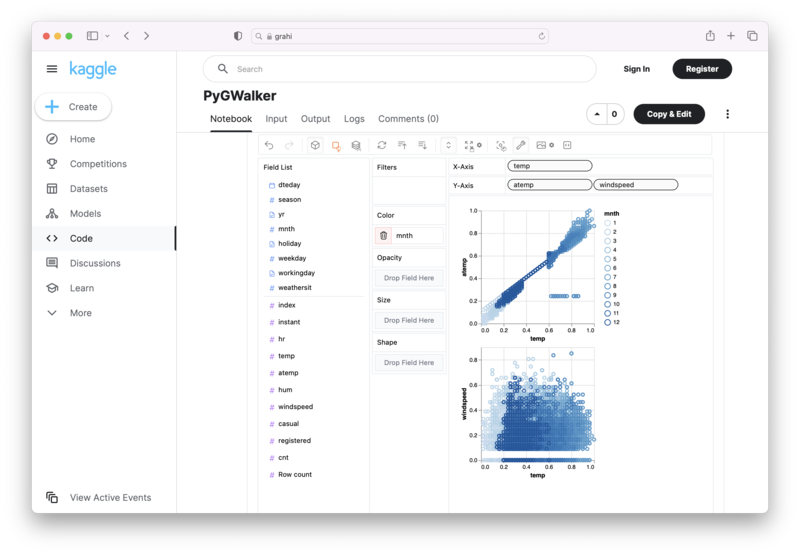A Simple Guide to Pandas Dataframe Operations
Updated on
Are you a beginner in data science or a professional looking to up your game? Have you heard about Pandas and its significance in the world of data science? If yes, you're in the right place. In this guide, we'll explore the basics of Pandas dataframes and various operations that can be performed on them.
Want to quickly create Data Visualizations in Python?
PyGWalker is an Open Source Python Project that can help speed up the data analysis and visualization workflow directly within a Jupyter Notebook-based environments.
PyGWalker (opens in a new tab) turns your Pandas Dataframe (or Polars Dataframe) into a visual UI where you can drag and drop variables to create graphs with ease. Simply use the following code:
pip install pygwalker
import pygwalker as pyg
gwalker = pyg.walk(df)You can run PyGWalker right now with these online notebooks:
And, don't forget to give us a ⭐️ on GitHub!
What is Pandas?
Pandas is an open-source Python library that provides high-performance, easy-to-use data structures and data analysis tools. It is widely used in the field of data science for data cleaning, data exploration, data modeling, and data visualization.
Why is Pandas important in data science?
Pandas has become an essential tool for data scientists as it simplifies the process of data manipulation and analysis. It offers a variety of functions that make it easy to work with large datasets, handling missing data, and reshaping data. It also integrates well with other Python libraries such as NumPy, SciPy, and Matplotlib, making it a popular choice for data analysis tasks.
What are the advantages of using Pandas dataframes?
Pandas dataframes are two-dimensional, size-mutable, and potentially heterogeneous tabular data structures with labeled axes (rows and columns). Some advantages of using Pandas dataframes include:
- Handling missing data
- Data alignment and integrated handling of data
- Reshaping and pivoting of data sets
- Label-based slicing, indexing, and subsetting of large data sets
- GroupBy functionality for aggregating and transforming data
- High-performance merging and joining of data
- Time Series functionality
How can I install Pandas?
To install Pandas, open your command prompt or terminal and run the following command:
pip install pandasAlternatively, if you're using Anaconda, run this command:
conda install pandasWhat are the basic operations that can be performed on a Pandas dataframe?
Once you have Pandas installed, you can perform various operations on dataframes such as:
- Creating a dataframe
- Reading data from files (e.g., CSV, Excel, JSON)
- Selecting, adding, and deleting columns
- Filtering and sorting data
- Merging and joining dataframes
- Grouping and aggregating data
- Handling missing values
- Applying mathematical operations on data
- Data visualization
How can missing values be handled in a Pandas dataframe?
Pandas offers several methods to handle missing values in a dataframe, such as:
dropna(): Remove missing valuesfillna(): Fill missing values with a specified value or method (e.g., forward fill, backward fill)interpolate(): Fill missing values with interpolated values (e.g., linear interpolation)
What is the GroupBy function in Pandas?
The GroupBy function in Pandas is a powerful method that allows you to group your data based on certain criteria, such as a column or index. Once the data is grouped, you can perform various aggregation and transformation operations on each group. Some common functions used with GroupBy include:
sum(): Compute the sum of each groupmean(): Compute the mean of each groupcount(): Compute the count of each groupmin(): Compute the minimum value of each groupmax(): Compute the maximum value of each group
How can mathematical operations be performed on the data in a Pandas dataframe?
Pandas dataframes support various mathematical operations, such as addition, subtraction, multiplication, and division, which can be applied element-wise or column-wise. Some commonly used functions for mathematical operations include:
add(): Add corresponding elements of two dataframessubtract(): Subtract corresponding elements of two dataframesmultiply(): Multiply corresponding elements of two dataframesdivide(): Divide corresponding elements of two dataframesmod(): Calculate the modulus of corresponding elements of two dataframespow(): Raise elements of one dataframe to the power of elements of another dataframe
You can also use the built-in Python arithmetic operators (+, -, *, /, %, **) to perform these operations.
Can data visualization be done using Pandas?
Yes, Pandas offers a variety of data visualization techniques using its built-in plotting methods, which are built on top of the popular data visualization library Matplotlib. Some common Pandas plot examples include:
- Line plots
- Bar plots
- Histograms
- Box plots
- Scatter plots
- Pie charts
To create a simple line plot, for example, you can use the plot() method as follows:
import pandas as pd
# Create a sample dataframe
data = {'A': [1, 2, 3, 4, 5], 'B': [5, 4, 3, 2, 1]}
df = pd.DataFrame(data)
# Create a line plot
df.plot()Conclusion
In conclusion, Pandas is a powerful and flexible library that simplifies the process of data manipulation and analysis in Python. This guide has covered the basics of Pandas dataframe operations, including dataframe creation, reading data from files, handling missing values, using the GroupBy function, performing mathematical operations, and data visualization. With these tools at your disposal, you are well on your way to becoming a more proficient data scientist.
More Pandas Tutorials:
- Basics of Pandas Dataframe
- Pandas Dataframe Examples
- Data Cleaning in Pandas Dataframe
- How to Plot with Pandas Dataframe
- Use read_csv() with Pandas Dataframe
- Faster Your Pandas Operation with Modin
- Reshape Data with Pivot and Melt
- Merge and Join in Pandas (SQL-style)
- What is Groupby in Pandas?
- Pandas 2.0: What's New?


